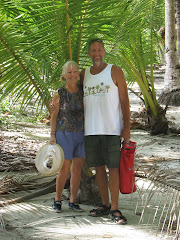
We made it through the Panama Canal, and we are now sitting in the Western Caribbean. How great is that? Our trip through the canal was flawless and easy. The weather was perfect all the way and we were able to make it in one day. I had gone through the canal, on another boat 4 days earlier, so I knew what to expect and that made my trip so easy. My one hired line handler and my friends from Leo Scotia and Panchita were awesome. For those coming behind me I would recommend Luis as a competent crew. He treated me well. His phone number is 67770222. He also arranged for lines and cabs. Now the other side of the story!!!
We were told on Monday that our advisor would be at our boat at 6:00 am by the canal control. Everyone knows they are always late so my crew for the trip was going to arrive at 5:45 giving us plenty of time to get ready. Last Friday, on the boat I went through on, the advisor was 1 1/2 hours late. At 5:20am Signal Control calls me and tells me my advisor will be there in 15 to 20 minutes, and I have no crew. I see my crew on the dock at the same time the pilot calls me and say he is here and could I bring the boat out into the channel it meet him. I still had no crew on the boat. I figured I had to take the boat into the fuel dock to pick up everybody instead of waiting for a panga. On my way to the dock in the dark I ran over a mooring line and wrapped it around my prop. This is a 1 inch line and it stops me dead, Oh %%%%#!#!!#!!!#####(abbreviated short version of the 4 minute ranting and raging. My crew isn't on the boat, the pilot is out in the channel waiting, and if I cancel the trip now it would cost me about $1500 plus maybe some fines as well. It is still dark so I put on my mask, no fins, and jump in the water with a fishing knife to see if I can cut myself loose. I have zero visibility because it is dark!!! I find my prop and start hacking away at everything, including my hand, as best I could. Each time I went down I had to search for the prop in the dark and only had a couple of seconds to keep cutting. After about 5 minutes I had enough of the line cut away that the prop would turn. I still felt a big knot but I had to get going. I made it out to the pilot boat about 10 minutes late, but the shaft was vibrating pretty bad. My Auto Prop wouldn't pitch right so I could only go 6.4 knots. I decided to give it a shot anyway thinking I would ruin the cutlass bearing, but hopefully make it through. If I would have broken down in the canal and had to be towed it would cost $2000 an hour for the tow, plus a whole bunch of fine and penalties. We actually made pretty good time and were able to go through the last locks with a small freighter at 2:50. We were told it would be a two day passage so I was very excited to get through in one day. We limped into Shelter Bay and found a slip. Yesterday I dove on the boat and discovered more damage than I expected. There was in fact a huge knot of rope still around my prop, and all the vibration had broken off my strut which supports my drive shaft. I was really lucky to make it through at all. Now I have to figure out what to do. I am able to haulout here which is a real blessing, but it is very expensive to do so. I now have plenty of time to figure it out. I am just stuck here in Paradise till I do.
Helen's last week on the boat(she goes home for 3 months to spend time with her mom) will be here, at a marina sitting around a pool, sitting in an air-conditioned room doing the internet, or reading on a soft cushy couch in air conditioning. She says she can handle that for a week. I however will be here off and on for two months. So by the end of my time here I will know everyone's name, life story, and have tons of new stories. I was planning a trip home and now my shopping list is a bit longer... till later our thoughts and love...and yes, life is still good!
I just found out the part I mess up is over $1000 ugh
----------
radio email processed by SailMail
for information see: http://www.sailmail.com






